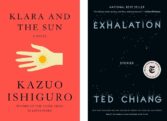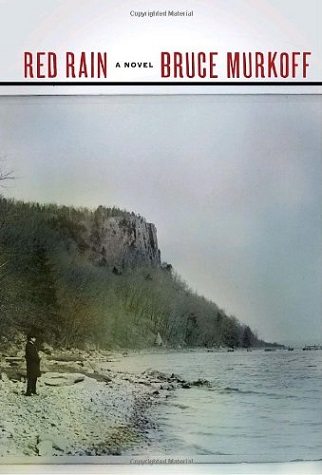
by by Margaret Kolb

Published by Knopf, 2010 | 352 pages
Bruce Murkoff's writing gives the impression he thinks in sepia tones. Such is the clarity of the prose in his second novel, Red Rain.
Set during the Civil War in the Hudson River Valley town of Roundout, New York, Red Rain begins just after the Union Army defeat at Cold Harbor, one of the bloodiest battles of the war. While not a principle driver or the plot, the battle’s shadow hangs heavy over the town and the principle characters of the novel as they go about their lives, trying to move on in the face of the destruction and death surrounding them. This endeavor is met with varying degrees of success and failure.
Red Rain is composed of plot lines as numerous and free flowing as the rivers that snake the western lands which Will Harp, the story’s principle character, has run from. But as all rivers eventually converge in the sea, so too do Murkoff’s plot lines link, coming together in a primordial swamp entombing the bones of a giant mastodon. It is in this swamp that Will Harp spends most of his time. After purchasing the swamp from a neighbor all too willing to sell, Will sets out to uncover the monster and reassemble its bones, metaphorically reconstructing himself, and reconciling a past that broke him into just as many pieces.
Will is a doctor, a veteran of campaigns waged against the Indians of the West, and a prodigal son who arrived home a bit too late to see his famous father, “the Major,” before he died. The first impression of him is that of a hard, troubled man, like someone out of a Cormac McCarthy novel. But if our first glimpse is of a man carved from granite, we soon discover the frailties of stone as we unearth the pieces of him that have broken off and been lost in the West. A witness to the massacre of Shoshone at Bear River and the destruction of countless young men, the blood on Will’s hands has leached through to his soul. Will is as complex and respectable a character as any writer could ever hope to create, and it is around him that this story is built.
Assisting Will with the excavation of the mastodon is his oldest friend, a photographer named Arthur. Arthur is a gentle, tortured soul, more focused on helping his friend through his troubles than attending to his own. Arthur is an artist longing to return to Paris to pick up a life he dare not discuss even with his closest friend. While Arthur does not narrate the story, Murkoff often makes him a lens to show rich, detailed pictures of the people in this time and place:
…Arthur came across old Jacob Quick riding to the swamp on his one-eared sorrel mule. The westerly breeze had pushed his long white beard toward his left shoulder, and the long nose in the center of his face was as sharp as a baling hook. He sat the mule straight as a youngster, guiding it along with a willow stick he held in his two-fingered hand. Arthur convinced him to pause for a moment, and the old man frowned down at him with all the gravity of Elijah, not allowing the slightest twitch as Arthur made his exposure.Pictures from this era show weathered men and women, haunting and powerful, who seem to look through us. It’s as though they were comprised of rare minerals from a quarry exhausted long ago. Murkoff has managed to capture this effect in his portrayals. Like the boats on the Hudson, Murkoff’s characters chug along with purpose. They are a steadfast, uncompromising lot. They meet a gaze and don’t back down. They are as quick to cock the hammer of a rifle as they are to offer a handshake. They smoke out intentions and hold firm to their beliefs. They are hard, and only bend to be broken. The book covers five months time, and it is over the course of those months that we gradually get to know its characters.
These characters include Mickey Blessing, a brutally strong Irish man at a time when the Irish had to be just that in order to survive. Almost loveable, Mickey supplies the muscle for the wealthiest, most ruthless man in Roundout; a monomaniac obsessed with acquiring the land of most everyone in the area (including Will Harp’s) by any means necessary in order to build his luxury hotel. Jane, Mickey’s sister, is a faithful, strong-willed war widow in waiting. Daily she checks the post for word of her fiancée, one of countless men standing in the way of Confederate cannons. Coley Hinds is a hard-working, hard-drinking boy of thirteen, too eager to grow up, to go west, and to stand up for and against things he doesn’t understand.
Like Murhoff’s acclaimed first novel, Waterborne, which focuses on the building of the Hoover Dam, the pace of Red Rain is measured and thoughtful. The novel's five chapters are divided by the five successive months of life in Roundout that play out here, creating the sense that life in this time was fuller than now, more monolithic; that it could not be divided, sequenced, or catalogued. The pace of life was slower. Murkoff captures this perfectly. He keeps his gaze focused on what is immediately at hand. Very rarely does he pan out to show the entire picture. Nothing is a blur in this world. The topography of this story and the contours of the characters are revealed page by page. The scenes of barges jogging methodically up and down the Hudson, of men working at the docks, of people walking and children playing on the dusty streets of the working-class, yet ambitious town of Roundout are vivid and poignant. There are no great epiphanies to be revealed in Red Rain, the novel is much too real for that.
Perhaps an accompaniment to Charles Frazier’s tale of the South, Cold Mountain, Red Rain is a story about the North. The Civil War’s destruction was just on the doorstep of the North, an ancillary character, if you will, not in its parlor, taking center stage as it did in Cold Mountain.In Red Rain, the war does swallow its share of young men, returning them as amputees, if at all, but Murkoff leaves enough distance between his story and the misery of the war to keep the focus on his characters.
In keeping with the period, Knopf has produced Red Rain with a wonderfully-done deckled edge edition, with jacket photographs well-suited for a Ken Burns documentary, immediately instilling the proper sense of time and emotion to the novel.
If Red Rain is about any one thing, that thing is buried with the mastodon. Like the Hudson, the story moves gracefully and slowly, gliding back and forth between characters, between the present and past, between the passions that drive the characters and the vices that cripple them. While the excavation of the beast is the central storyline, and the ground on which the characters meet, the novel is essentially about all the infinite particulars of life, and the finding of peace with them, be it in the bones of an extinct creature, the arms of a lover, or the finality of death. As we can learn from the mastodon, the dead still have their bones, and bones say plenty. Things that are buried eventually resurface. Peace isn’t in the ground; it is what we must find before we get there.
SD Allison was born in Nebraska. He is the descendant of farmers, teachers, and men with bad lungs. He is the father of a little boy with autism. His first novel, Beneath the Plastic, was published in 2006. He is currently a senior copy writer for a marketing/ad agency.















click to see who
MAKE Magazine Publisher MAKE Literary Productions Managing Editor Chamandeep Bains Assistant Managing Editor and Web Editor Kenneth Guay Fiction Editor Kamilah Foreman Nonfiction Editor Jessica Anne Poetry Editor Joel Craig Intercambio Poetry Editor Daniel Borzutzky Intercambio Prose Editor Brenda Lozano Latin American Art Portfolio Editor Alejandro Almanza Pereda Reviews Editor Mark Molloy Portfolio Art Editor Sarah Kramer Creative Director Joshua Hauth, Hauthwares Webmaster Johnathan Crawford Proofreader/Copy Editor Sarah Kramer Associate Fiction Editors LC Fiore, Jim Kourlas, Kerstin Schaars Contributing Editors Kyle Beachy, Steffi Drewes, Katie Geha, Kathleen Rooney Social Media Coordinator Jennifer De Poorter
MAKE Literary Productions, NFP Co-directors, Sarah Dodson and Joel Craig